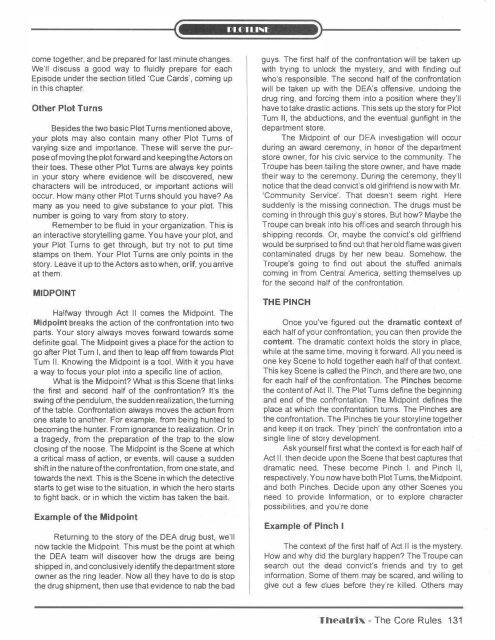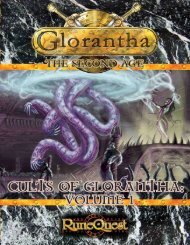Untitled - Index of - Free
Untitled - Index of - Free
Untitled - Index of - Free
Create successful ePaper yourself
Turn your PDF publications into a flip-book with our unique Google optimized e-Paper software.
come together, and be prepared for last minute changes.<br />
We'll discuss a good way to fluidly prepare for each<br />
Episode under the section titled 'Cue Cards', coming up<br />
in this chapter.<br />
Other Plot Turns<br />
Besides the two basic Plot Turns mentioned above,<br />
your plots may also contain many other Plot Turns <strong>of</strong><br />
varying size and importance. These will serve the pur<br />
pose <strong>of</strong> moving the plot forward and keeping the Actors on<br />
their toes. These other Plot Turns are always key points<br />
in your story where evidence will be discovered, new<br />
characters will be introduced, or important actions will<br />
occur. How many other Plot Turns should you have? As<br />
many as you need to give substance to your plot. This<br />
number is going to vary from story to story.<br />
Remember to be fluid in your organization. This is<br />
an interactive storytelling game. You have your plot, and<br />
your Plot Turns to get through, but try not to put time<br />
stamps on them. Your Plot Turns are only points in the<br />
story. Leave it up to the Actors as to when, or if, you arrive<br />
at them.<br />
MIDPOINT<br />
Halfway through Act II comes the Midpoint. The<br />
Midpoint breaks the action <strong>of</strong> the confrontation into two<br />
parts. Your story always moves forward towards some<br />
definite goal. The Midpoint gives a place for the action to<br />
go after Plot Turn I, and then to leap <strong>of</strong>f from towards Plot<br />
Tum II. Knowing the Midpoint is a tool. With it you have<br />
a way to focus your plot into a specific line <strong>of</strong> action.<br />
What is the Midpoint? What is this Scene that links<br />
the first and second half <strong>of</strong> the confrontation? It's the<br />
swing <strong>of</strong> the pendulum, the sudden realization, the turning<br />
<strong>of</strong> the table. Confrontation always moves the action from<br />
one state to another. For example, from being hunted to<br />
becoming the hunter. From ignorance to realization. Or in<br />
a tragedy, from the preparation <strong>of</strong> the trap to the slow<br />
closing <strong>of</strong> the noose. The Midpoint is the Scene at which<br />
a critical mass <strong>of</strong> action, or events, will cause a sudden<br />
shift in the nature <strong>of</strong> the confrontation, from one state, and<br />
towards the next. This is the Scene in which the detective<br />
starts to get wise to the situation, in which the hero starts<br />
to fight back, or in which the victim has taken the bait.<br />
Example <strong>of</strong> the Midpoint<br />
Returning to the story <strong>of</strong> the DEA drug bust, we'll<br />
now tackle the Midpoint. This must be the point at which<br />
the DEA team will discover how the drugs are being<br />
shipped in, and conclusively identify the department store<br />
owner as the ring leader. Now all they have to do is stop<br />
the drug shipment, then use that evidence to nab the bad<br />
guys. The first half <strong>of</strong> the confrontation will be taken up<br />
with trying to unlock the mystery, and with finding out<br />
who's responsible. The second half <strong>of</strong> the confrontation<br />
will be taken up with the DEA's <strong>of</strong>fensive, undoing the<br />
drug ring, and forcing them into a position where they'll<br />
have to take drastic actions. This sets up the story for Plot<br />
Turn II, the abductions, and the eventual gunfight in the<br />
department store.<br />
The Midpoint <strong>of</strong> our DEA investigation will occur<br />
during an award ceremony, in honor <strong>of</strong> the department<br />
store owner, for his civic service to the community. The<br />
Troupe has been tailing the store owner, and have made<br />
their way to the ceremony. During the ceremony, they'll<br />
notice that the dead convict's old girlfriend is now with Mr.<br />
'Community Service'. That doesn't seem right. Here<br />
suddenly is the missing connection. The drugs must be<br />
coming in through this guy's stores. But how? Maybe the<br />
Troupe can break into his <strong>of</strong>fices and search through his<br />
shipping records. Or, maybe the convict's old girlfriend<br />
would be surprised to find out that her old flame was given<br />
contaminated drugs by her new beau. Somehow, the<br />
Troupe's going to find out about the stuffed animals<br />
coming in from Central America, setting themselves up<br />
for the second half <strong>of</strong> the confrontation.<br />
THE PINCH<br />
Once you've figured out the dramatic context <strong>of</strong><br />
each half <strong>of</strong> your confrontation, you can then provide the<br />
content. The dramatic context holds the story in place,<br />
while at the same time, moving it forward. All you need is<br />
one key Scene to hold together each half <strong>of</strong> that context.<br />
This key Scene is called the Pinch, and there are two, one<br />
for each half <strong>of</strong> the confrontation. The Pinches become<br />
the content <strong>of</strong> Act II. The Plot Turns define the beginning<br />
and end <strong>of</strong> the confrontation. The Midpoint defines the<br />
place at which the confrontation turns. The Pinches are<br />
the confrontation. The Pinches tie your storyline together<br />
and keep it on track. They 'pinch' the confrontation into a<br />
single line <strong>of</strong> story development.<br />
Ask yourself first what the context is for each half <strong>of</strong><br />
Act II, then decide upon the Scene that best captures that<br />
dramatic need. These become Pinch I, and Pinch II,<br />
respectively. You now have both Plot Turns, the Midpoint,<br />
and both Pinches. Decide upon any other Scenes you<br />
need to provide Information, or to explore character<br />
possibilities, and you're done.<br />
Example <strong>of</strong> Pinch I<br />
The context <strong>of</strong> the first half <strong>of</strong> Act II is the mystery.<br />
How and why did the burglary happen? The Troupe can<br />
search out the dead convict's friends and try to get<br />
information. Some <strong>of</strong> them may be scared, and willing to<br />
give out a few clues before they're killed. Others may<br />
Theatrlx- The Core Rules 131



